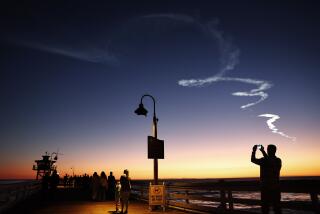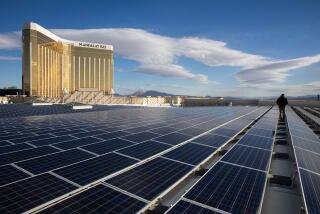Solar airplane begins first leg of trip across America
- Share via
A spindly solar-powered aircraft took to the skies Friday from Moffett Federal Airfield, near San Francisco, on a pioneering coast-to-coast flight that will not use one ounce of fossil fuel.
The plane, called Solar Impulse HB-SIA, has an immense 208-foot wing covered with 12,000 solar cells that soak up the sun’s rays and power the plane’s four electric motors while simultaneously charging batteries. That means the plane can keep flying at night.
The goal is not speed, because it’s traveling a leisurely 43 mph. Nor is it endurance, because it’s making the trip in five legs.
Rather, the objective is to showcase clean technology.
So while the first leg is an excruciatingly long 18-hour trip from Moffett Field to Phoenix Sky Harbor International Airport, the flight was enthralling to pilot Bertrand Piccard.
“It’s never boring because it’s the most revolutionary airplane that exists — an airplane that flies day and night with no fuel,” he said a few hours into his trip, soaring at around 13,000 feet above Northern California.
He took off from Moffett Field at about 6 a.m. Pacific time and is set to land in Phoenix at 1 a.m. Mountain time Saturday. In all, the cross-country voyage is expected to take about two months. After Phoenix, there are stops in Dallas, St. Louis, Washington, D.C., and finally at John F. Kennedy International Airport in New York.
The solar plane was created by Piccard and engineer Andre Borschberg, both Swiss nationals. The two have raised money since 2003 from corporate sponsors and investors, such as Swiss watch manufacturer Omega and Belgian chemicals group Solvay.
Solar Impulse flew for the first time in 2009, soaring 3 feet off the ground for 28 seconds. Work continued and by the next year Solar Impulse made a 26-hour flight in Switzerland on the world’s first solar-powered night flight.
In 2011 the plane made its first international flight from Switzerland to Belgium to France. Last year it took on the first solar-powered intercontinental flight, flying from Europe to North Africa in eight legs over two months.
The plane is slow-moving and has a cruise altitude of 21,000 feet. So when Solar Impulse’s creators proposed a flight across the U.S., they had to work with the Federal Aviation Administration to ensure that there would be no danger to commercial aircraft.
“Everybody has been trying to figure out how to integrate such an aircraft into the heavy air traffic of the West Coast,” Borschberg said. “It hasn’t been done before.”
Everything on the Solar Impulse HB-SIA aircraft has been designed to save energy. It weighs just 3,527 pounds because of its lightweight structure, flight instrumentation and engines.
There are four pods fixed under the wings and each contains an electric motor with a maximum power output of 10 horsepower.
Because the aircraft has only one seat, Piccard and Borschberg plan on taking turns flying the plane. One will follow the other in a turboprop aircraft to the various locations.
People who are interested in the trip can follow virtually at the website https://www.solarimpulse.com.
Piccard and Borschberg are planning to fly around the world in a second plane in 2015. That flight will take place over 20 days and 20 nights, with several stops along the way.
More to Read
Inside the business of entertainment
The Wide Shot brings you news, analysis and insights on everything from streaming wars to production — and what it all means for the future.
You may occasionally receive promotional content from the Los Angeles Times.











